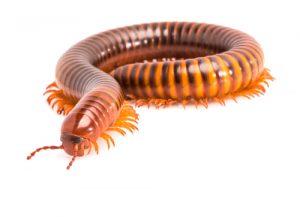Managing Millipedes
By Chris Williams on December 21, 2011.
Q. We seem to have an ongoing problem with millipedes getting into our house. In the fall, we get fairly large numbers inside by the back door. And it seems like I always find a few here and there, no matter what time of year it is. Where are they coming from?
A. Outdoors, millipedes are found where it’s damp: in leaf litter, mulch, flower beds, compost, rotting wood, and under stones and debris, where they feed on decaying plant materials and scavenge on dead insects. They may build up to high numbers in heavily watered lawns or wooded yards with accumulations of rotting leaves. Indoors, millipedes are found in areas with the highest moisture levels: in bathrooms, basements or crawlspaces, or around sump pumps, under washers, around laundry sinks or floor drains. But because most homes don’t have any areas damp enough for millipedes to survive on a long term basis, they usually die fairly soon after they make their way indoors.
Millipedes don’t bite and they don’t damage furnishings in your home; they’re just a nuisance. So, unless you’re dealing with a millipede migration (see below), pesticides are usually not necessary. There are things you can do to keep millipedes from getting in and a broom or vacuum can pick up those that mange to get in anyway.
 Millipedes are known for migrating in large numbers in the fall when they look for places to spend the winter, or when their outdoor areas become too wet or too dry. Large numbers of millipedes may enter garages, basements, and ground floor living areas during these migrations and can become quite a pest problem. Most invasions occur on the shady side of the home.
Millipedes are known for migrating in large numbers in the fall when they look for places to spend the winter, or when their outdoor areas become too wet or too dry. Large numbers of millipedes may enter garages, basements, and ground floor living areas during these migrations and can become quite a pest problem. Most invasions occur on the shady side of the home.
You can eliminate millipedes in your home with a three-pronged attack, by (1) drying them out, (2) blocking them out, and (3) with a timed outside perimeter treatment.
(1) Drying them out – You can dry them out on the outside by dethatching your lawn and keeping it closely mowed. This allows the lawn to dry out more quickly and reduces millipede habitat. Water your lawn and garden in early morning so the vegetation dries out during the day and doesn’t remain wet overnight. Remove rotting wood and piles of mulch, leaves, or grass clippings near your house that attract millipedes. Dry them out inside your home by using ventilation to reduce humidity in basements, crawlspaces, garages and other areas with chronic moisture problems.
(2) Blocking them out – Remove vegetation and mulch that is directly around your foundation. Rake back mulch and remove grass to create a 12 inch wide barrier around your home. This will cut down on the number of invading outdoor pests, including millipedes. Seal cracks and crevices around doors and ground floor windows, particularly in below-grade window wells. Add sweeps or weather stripping to loose-fitting doors, especially garage doors. If you don’t want to do this pest-proofing yourself, Colonial offers a pest-proofing service to keep pests from getting inside.
(3) Outside perimeter treatment – Have a pest control company create a barrier around your home with an outdoor treatment of pesticide applied around the foundation. Colonial offers a semi-annual, low-impact exterior pest control treatment that is specifically targeted to intercept pests that try to move indoors. If you’ve had a problem with fall millipede migrations in the past, we can schedule the treatment to stop those millipedes, and other fall invaders, in their tracks. Give Colonial a call.